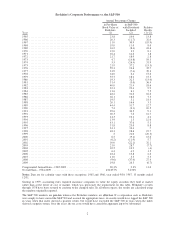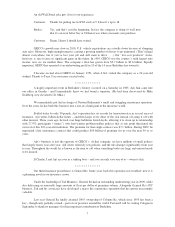Berkshire Hathaway 2009 Annual Report Download - page 5
Download and view the complete annual report
Please find page 5 of the 2009 Berkshire Hathaway annual report below. You can navigate through the pages in the report by either clicking on the pages listed below, or by using the keyword search tool below to find specific information within the annual report.
BERKSHIRE HATHAWAY INC.
To the Shareholders of Berkshire Hathaway Inc.:
Our gain in net worth during 2009 was $21.8 billion, which increased the per-share book value of both
our Class A and Class B stock by 19.8%. Over the last 45 years (that is, since present management took over)
book value has grown from $19 to $84,487, a rate of 20.3% compounded annually.*
Berkshire’s recent acquisition of Burlington Northern Santa Fe (BNSF) has added at least 65,000
shareholders to the 500,000 or so already on our books. It’s important to Charlie Munger, my long-time partner,
and me that all of our owners understand Berkshire’s operations, goals, limitations and culture. In each annual
report, consequently, we restate the economic principles that guide us. This year these principles appear on pages
89-94 and I urge all of you – but particularly our new shareholders – to read them. Berkshire has adhered to these
principles for decades and will continue to do so long after I’m gone.
In this letter we will also review some of the basics of our business, hoping to provide both a freshman
orientation session for our BNSF newcomers and a refresher course for Berkshire veterans.
How We Measure Ourselves
Our metrics for evaluating our managerial performance are displayed on the facing page. From the start,
Charlie and I have believed in having a rational and unbending standard for measuring what we have – or have
not – accomplished. That keeps us from the temptation of seeing where the arrow of performance lands and then
painting the bull’s eye around it.
Selecting the S&P 500 as our bogey was an easy choice because our shareholders, at virtually no cost, can
match its performance by holding an index fund. Why should they pay us for merely duplicating that result?
A more difficult decision for us was how to measure the progress of Berkshire versus the S&P. There are
good arguments for simply using the change in our stock price. Over an extended period of time, in fact, that is
the best test. But year-to-year market prices can be extraordinarily erratic. Even evaluations covering as long as a
decade can be greatly distorted by foolishly high or low prices at the beginning or end of the measurement
period. Steve Ballmer, of Microsoft, and Jeff Immelt, of GE, can tell you about that problem, suffering as they do
from the nosebleed prices at which their stocks traded when they were handed the managerial baton.
The ideal standard for measuring our yearly progress would be the change in Berkshire’s per-share intrinsic
value. Alas, that value cannot be calculated with anything close to precision, so we instead use a crude proxy for
it: per-share book value. Relying on this yardstick has its shortcomings, which we discuss on pages 92 and 93.
Additionally, book value at most companies understates intrinsic value, and that is certainly the case at
Berkshire. In aggregate, our businesses are worth considerably more than the values at which they are carried on
our books. In our all-important insurance business, moreover, the difference is huge. Even so, Charlie and I
believe that our book value – understated though it is – supplies the most useful tracking device for changes in
intrinsic value. By this measurement, as the opening paragraph of this letter states, our book value since the start
of fiscal 1965 has grown at a rate of 20.3% compounded annually.
*All per-share figures used in this report apply to Berkshire’s A shares. Figures for the B shares are
1/1500th of those shown for A.
3


















